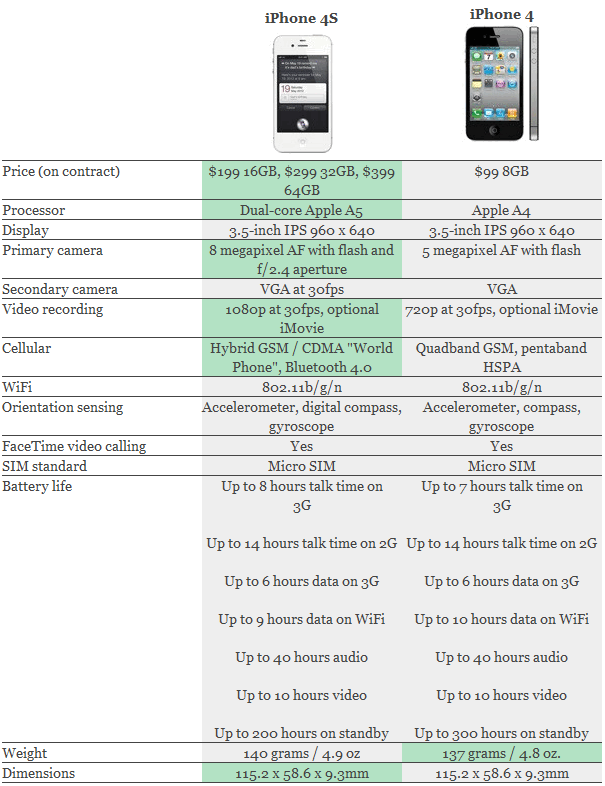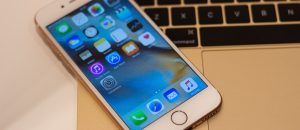Yesterday Apple revealed their next iPhone, iPhone 4S. As the name may imply, iPhone 4S is a refreshed iPhone 4; it has the exact same body/design and screen as the iPhone 4 but with better internals: A better CPU, GPU, camera, hybrid GSM/CDMA radios [with support for HSPA+ but not LTE or WiMax], and Siri-enabled voice control. The following chart, put together by our friends at Engadget, compares iPhone 4 vs iPhone 4S:
(Click on the chart above to view it in full size.)
Those who have followed the iPhone since its release in 2007 know that Apple has pulled a stunt similar as this one in the past, with the iPhone 3GS. However, the iPhone 3GS was released in 2009; back then Apple had only budding competition when the majority of the smartphone world still used Symbian, BlackBerry was a respected name, and Android was getting its feet wet. In 2009 Apple could afford to get away with simply refreshing the most popular smartphone in the world. Now, in October of 2011 where there are excellent viable alternatives to the iPhone, a refresh of the iPhone 4 is a major disappointment.
Don’t get me wrong. The iPhone 4S is not/will not be a “bad” phone: iPhone 4S is powered by Apple’s powerful A5 dual-core processor combined with dual-core PowerVR SGX543 GPU chips; and it still contains all the attractive aspects of the iPhone 4 such as the much-praised Retina display and excellent battery life. For all intents and purposes, iPhone 4S will be a good phone with an excellent user experience; and it does rival the competition (as they stand right now). However, by simply refreshing the iPhone 4, Apple has missed a trick or two. Or three.
As all industry followers know, dual-core processors – and accompanying multi-core GPUs – are nothing new. Tegra 2 has been out for a long time; Samsung and QualcomM have their own multi-core processors out; and even Apple’s A5 is 8-ish months old — it was first available in the iPad 2 in March of this year. True, A5 is a strong processor with the graphics performance of the PowerVR chips being the highlight of the equation (dual-core PowerVR SGX543 provides what is arguably one of the most powerful, if not the most powerful, graphics performance out on the market at this time); but if you look at it from a consumer’s perspective, Apple is simply showing up to the dual-core game 8-10 months late. Releasing an iPhone in October with a dual-core processor and flashing it around as the next big thing isn’t going to win over many people who have been seeing dual-core processors in phones since the start of the year.
However it isn’t the processor/GPU of the iPhone 4S that bother me. Aside from releasing the iPhone 4S earlier in the year (such as their traditional June release cycle), there isn’t much Apple could have done in terms of processor/GPU that they they haven’t done already. Quad-cores are not market ready yet and Apple’s A5 + PowerVR SGX543 provide excellent performance. Where I feel Apple missed the boat is physical design, screen size, and data connectivity.
Similar to the “new car smell”, when you buy a new phone there is that “new phone feeling”: Your palms are sweaty, your eyes are watery, you get a boner, and your heart is pounding. When you buy a phone that looks and feels the exact same as your previous phone (i.e. iPhone 4 -> iPhone 4S) this “new phone feeling” is highly diminished, if you experience it all. After all, your new phone looks the same as your old phone, it feels the same as your old phone, it smells the same as your old phone, and it runs the exact same apps in the exact same manner. Yeah the menu may open up more quickly due to your new phone having a better processor, but is that reason enough to go for this new phone? I know I am being overly cynical, but my point is that using a 17 month-old design does injustice to those loyalists that are ditching their iPhone 4 for an iPhone 4S. (There is a redeeming factor to using the same design and that is the ability to reuse accessories. Reusing iPhone 4 accessories on the iPhone 4S will save consumers some money, but I would argue reusing accessories further diminishes the “new phone feeling”.)
Of course my above point about physical design is applicable if you already own an iPhone 4 and plan on upgrading to an iPhone 4S. What if you are an iPhone 3GS (or iPhone 3G or iPhone 2G) user or are new to the iPhone family? Does the fact that iPhone 4S has the same physical design as the iPhone 4 matter to you? I would argue it does. Sure you may not experience the lack-of-new-phone-feeling quagmire mentioned above but do you really want to go around telling people you have the latest and greatest iPhone? In other words, would you rather people see and immediately recognize you shelled out the $$$ for the latest iPhone or would you rather they ask you “is that the iPhone 4 or iPhone 4S?” I would argue most people prefer the former over the later. To illustrate my point, let’s look at the hybrid cars example. Did you know Honda was the first car company to bring hybrid cars to the United States? Even though Honda was first, the Toyota Prius wiped the floor with them. Why? One of the biggest factors was because the Prius had (has) a distinct look to it, whereas Honda hybrids had a simple badge on the back of the car proclaiming their hybrid status. People who bought hybrid vehicles wanted others to know the fact that they own a hybrid. A Prius allowed people to do that while Honda hybrids did not. iPhone 4S using the same physical design as the iPhone 4 is similar to Honda hybrids looking the same as regular Honda’s: It doesn’t allow people to show off.
That, then, brings me to my next point — screen size. Since its release, the iPhone has kept the tradition of having a 3.5 inch screen. 3.5 inches is a good screen size… nothing wrong with that, right? Wrong. A lot of people proclaim “3.5 inches is the perfect size for a phone”; and some people may indeed enjoy 3.5 inches. However, when the competition is offering customers the choice of screens ranging from 3.2 inches to 4.5 inches – with the majority of high-end phones being 3.75 inches or larger – 3.5 inches just does not cut it anymore. At this point many people are probably thinking “but a 4.5 inch screen is too big”; and for some people it may indeed be too big. Preferable screen size is largely a matter of personal opinion. (Personally speaking, I feel the ideal screen size is somewhere between 3.75-4.3 inches with 4 inches being the sweet spot.) However, in addition to personal preference, market choice and product availability also play a large role in being satisfied with screen size.
Think back to the iPhone 2G (the original iPhone). It debuted with a 3.5 inch screen. Back then, 3.5 inch screens were unheard of. While there may have been a few phones with a 3.5 inch screen or larger, by and large the screens on phones were smaller. At that time I am sure many people were turned off by the “big” 3.5 inch screen. Now, however, 3.5 inches is something that gets scoffed at; and that is my main point. A 3.5 inch screen worked well from iPhone 2G-iPhone 4 because the competition couldn’t offer anything significantly better. Now the competition has much larger screens; and trust me when I say this: When you use a phone with a larger screen, it is hard to go back to a smaller screen. While some people may still prefer the 3.5 inches of the iPhone, the lack of choice really hurts the iPhone 4S. The iPhone 4S may have a very powerful graphics processors, but playing games – or watching videos/movies – on a 3.5 inch screen isn’t nearly as fun as on, for example, a 4 incher. Apple would have been much better off giving iPhone 4S a larger screen. (A 4 inch screen would have been ideal.) This way people that want that larger screen could have gone with the iPhone 4S and people that don’t want it could have stuck with the iPhone 4 which is, by all standards, still a viable phone.
Lastly, let’s talk data connectivity. iPhone 4S comes with dual GSM/CDMA radios. In other words, an iPhone 4S can run on GSM and CDMA networks and works worldwide. (Hurray for world roaming!) The issue is iPhone 4S does not support 4G (LTE/WiMax) network connectivity. Yes, despite the “4” in its name, iPhone 4S does not have 4G. iPhone 4S does support HSPA+ but a) HSPA+ really isn’t 4G and b) the HSPA+ supported by iPhone 4S isn’t even the fastest HSPA+ available. The lack of LTE/WiMax support really hurts the iPhone 4S. True for many people, at this moment in time, the lack of 4G isn’t a big deal because their cell phone service providers don’t provide 4G coverage. However, for many that do live in a 4G area, the lack of LTE/WiMax support is potentially a deal crusher. If I am a Verizon customer, there is no way in digital hell I am going to tie myself down to a two-year contract with the iPhone 4S that runs on 3G when there are LTE Android phones available. Verizon has a blazing fast (!) LTE network that already covers a large part of the USA population and is continually expanding further. And I am not the only one that feels this way. I have talked to Verizon customers that have opted for Android devices over the iPhone 4 (this was prior to the release of the iPhone 4S, but the same logic applies) because of LTE support on the Android devices. While iPhone’s high resale value is a redeeming factor in the sense that one can sell an iPhone 4S and add a few hundred on top to buy an iPhone 5 when it comes out (assuming iPhone 5 supports 4G), but using iPhone’s resaleability as an excuse to not include 4G in the iPhone 4S is simply pathetic.
Love them or hate them, no one can deny Apple has been (is) a pioneer in the mobile computing industry. Even though I am an Android user (and I intend on staying with Android), I can say with confidence the success of the iPhone has forced other manufacturers to create better phones in order to challenge the market leader. With the release of the iPhone 4S, instead of setting the bar higher, Apple is simply playing catch-up to its competitors; and even in that regard Apple fails in some areas, as mentioned above. In a way it isn’t fair to rag on the iPhone 4S simply because it is “good” and not “great”. However, being the market leader, I fully expected Apple to continue leading the pack — not refresh its premier phone with what is essentially 6+ months old technology.
I am not predicating the death of the iPhone. The iPhone will not die; in fact, I predict the iPhone 4S will sell like crazy because, after all, it is an iPhone and it is a good phone. However, even if (when) millions of units are sold, the iPhone 4S is a disappointment in my book. Time to look towards the iPhone 5… whenever it comes out.

 Email article
Email article




